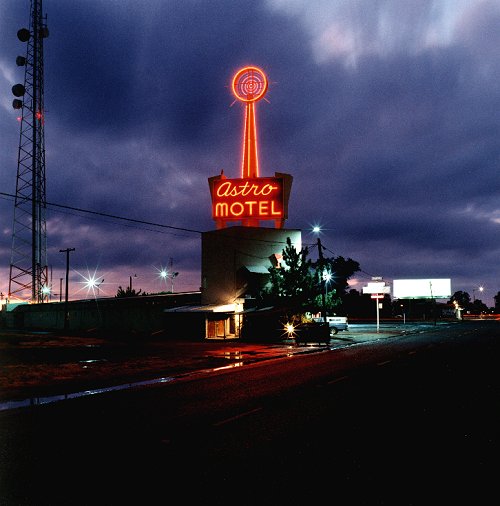September 30, 2004
Mars, as seen by Mars Express

Photo: Reuters
This picture taken by Mars Express shows a general view of Mars and a marked area north of Valles Marineris.
The image below shows the Ophir Chasma, a parallel valley to the north of the Valles Marineris:
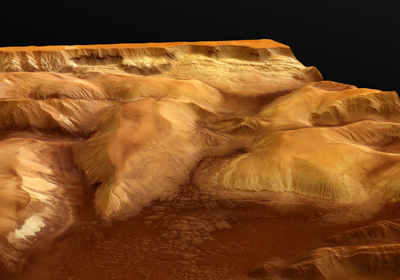
Perspective view of Ophir Chasma, looking north-east
An interactive map.
It is good to see the Europeans involved in space exploration.
September 29, 2004
Sean Sully
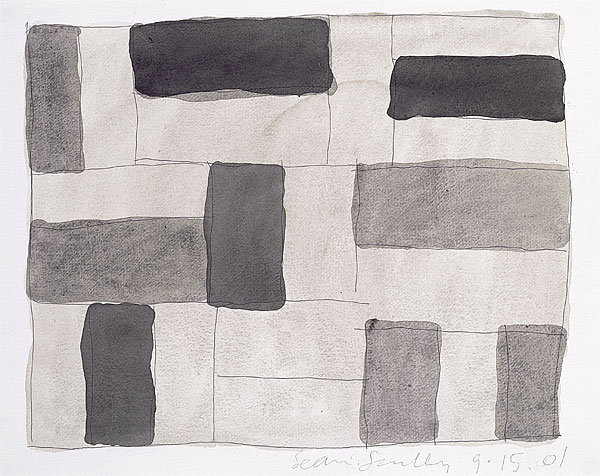
Sean Scully, 9.15.01 2001, from the series Body of Light
Sean Scully makes these remarks:
"Thereís a lot of force to these paintings. Thereís a lot of physical force to them, a lot of tactile sexual energy, a lot of sensuality. But thereís a lot of uncertainty about what the relationship between the parts actually means and I think that thatís a very important aspect of my work. I mean if I have to choose a course between Puritanism and extreme romanticism, I think itís clear than Iím going to choose extreme romanticism. But I think what I can contribute is something that has both in it, something that has the possibility of both in it, and itís that extreme stretch that I want to try to achieve in my work. Thatís my ambition."
I'm not sure about the force.
Nor am I sure what the middle course between puritanism and extreme romanticism is. What is Puritanism (with a captial P) in painting anyhow? Is it minimalism?
What is extreme romaticism? Does romanticism mean in painting? Decoration? Colour?
September 28, 2004
Otto Dix: Der Krieg
The National Gallery of Australia has just acquired a copy of Otto Dix's prints series of 50 etchings of war in WW1 called Der Krieg (The War).
During the war Dix's drawings war expressed the war that the war was a creative force. Der Krieg etchings were made after the war:

Otto Dix, Meal time in the Trenches, 1923/24
This work, which consists of 50 prints, has often been compared to Francisco de Goya's Los Desastres de la Guerra (1808-1814) for its authentic, devastating scenes of the horrifying front battles of World War I.

Otto Dix, Stormtroopers During Gas Attack, 1923/24
Der Kreig was published as five portfolios, each with 10 etchings in an edition of 70. Otto Dix mastered the technique of aquatint to depict the gruesome reality of battle, which he himself experienced during the First World War.
September 27, 2004
Radiohead: OK Computer
Joe Carducci put forth a particular view about rock music in his 1994 book, "Rock and the Pop Narcotic." He says that:
"The essence of quality in rock's musical terms is to be found in the musical interaction of the players of a guitar, a bass and a drum kit. Its special musical value is that it is a folk form which exhibits a small-band instrumental language as in jazz, rather than mere accompaniment to a vocalist as in pop."
Carducci's class-based text is directed at the taste of the so-called established '60s ďrock press and the puppet model of Motown or Phil Spector or Dick Clark. The latter are just producers who get a song and they are not real artists in the rock sense. Pop is a narcotic. Pop versus rock is debated here at ausculture. It's good.
Presumably Carducci's definition of rock music would include The Rolling Stones' Sticky Fingers It would include most punk bands, since Carducci's text is a defense of í80s post-punk bands that were mostly ignored by mainstream rock critics until Nirvana came along.
But Carducci's definition would exclude other kinds of music, such as Brian Wilson's Smile, because that album is the work of a composer and arranger, not players in a band. It would similarly exclude work that straddles the intersection where musical styles, and thus some of the work of Radiohead.
 I started listening to Radiohead's OK Computer yesterday for the first time. It was music of the 1990s and so different from Brian Wilson's Smile from the mid 1960s, the Grateful Dead's Stepping Out from the early 1970s, or the Rolling Stones Exile on Main Street from the same period.
I started listening to Radiohead's OK Computer yesterday for the first time. It was music of the 1990s and so different from Brian Wilson's Smile from the mid 1960s, the Grateful Dead's Stepping Out from the early 1970s, or the Rolling Stones Exile on Main Street from the same period.
I do not know Radiohead's earlier work---Pablo Honey and The Bends---nor the latter albums, such as Kid A, Amnesiac and Hail to the Thief. On OK Computer we have a rock band moving into the world of techno/electronica without sacrificing their guitars and bass and drums, whilst adding synthesizer and sound effect samples. I recoiled from the harsh swirling guitars of the opening track, found some of the music inaccessible and tortured, and noted the quieter acoustic sections and sound effects of a musical landscape.
I never really got round to sorting out the individual tracks. Nor did it actually matter as it was the overall 'atmopherics that come to the fore ---as in Exile on Main Street, Smile, or Live/Dead.
What I heard was very industrial, electronic and droned in a world weary way. We are living in a bleak industrial, technocratic and corporate world devoid of human emotion. We are depressed, with lots of fears, paranoia, and trying to cope with a general sickness---I guess we can use a Heideggerian term postmodern technological dread or anxiety that leaves us with a sense of emptiness.
It was a world away from The Kinks 1968 Village Green Preservation Society

Another world from the quiet world of the English village green.
The music on OK Computer is pushing towards being an expression of what it is to live within this technocratic territory---it is explored more fully in the more experimental Kid A, where the material often transgresses the song format.
 And Amnesiac apparently. In these albums Radiohead shift more fully into the world of electronic music.
And Amnesiac apparently. In these albums Radiohead shift more fully into the world of electronic music.
The music on OK Computer left me with a sense of emptiness and emotional bleakness.
My impression is that repeated listens would reveal all sorts of intersecting themes, repeated motifs, and shared themes--just as we find in the work of Brian Wilson in Pet Sounds and Smile. All sorts of things in the mix will contribute to the atmosphere of the album, little things, many of which I could not explain how it was done.
So a great deal of this albums power is due to the production.
September 26, 2004
Hans Bellmer: forbidden fruit?
I've been struggling with Pierre Klossowski's book on Nietzsche, 'Nietzsche and the Vicious Circle', and his conception of the conflicts between the impulses of the body and consciousness.
An example?
We have an impossible sexual longing for young girls leading to an art of bodies, which re-creates a sexual passion that invents new desires.
Little girls are not sexually available for middle aged men in our society. So what male artists do is envision and manufacture art works (eg., dolls) in their image. These can then be probed with aggressive fingers and captured rapaciously by a conscious male gaze.
What results is dread, an inner turmoil of conflicting desires, and twisted longing. It is not right to desire young girls nor to desire to mutiliate their bodies. So Bellmer's expression of these obsessional desires in images is kept hidden, only shown to a few surrealists in the art world.
This all changed when the internet was invented and porn was everywhere.
I do not want to give this a psychoanalytic interpretation of repressed unconcious desire versus the ego as moral conscience. I want to consider it in terms of an obsessional image produced instinctively by the life of the impulses. An example of such an image is Bellmer's dolls:
Such an image Klossowski calls a phantasme. By this he means that we have obsessional impulses or desires that seek to express themselves.
Klossowsski calls the conscious or willed expression (by Bellmer and Newton) of the phantasme a simulacra. A simulacra presupposes a set of sterotypes, which are the codes of everyday life. These sterotypes invert or betray the intensities of the bodies' chaotic impulses.
What is troubling about Klossowski is that there is no ethics involved. What the bodily desires are is accepted as okay, no matter what they are. Our bodily desires appear to be accepted as natural.
Does that mean it is okay to desire young girls, or to mutilate their bodies? Does it mean that it is our coded morality, which says these desires are wrong, that needs to rebelled against? Is this what Klossowski's idea of the combat against culture means?
This rejection of the ethical (the good) from art troubles me. There is something deeply wrong about the male gaze.
September 25, 2004
Brian Wilson presents Smile
(ďIíve been in this town so long that back in the City/Iím taken for lost and gone/And Iíve known for a long, long time"...
Heroes and Villains Brian Wilson & Van Dyke Parks
Heroes and Villains is a song which, along with its companion Good Vibrations, has become a part of the musical universe we all inhabit. They are part of Smile, a postmodern album that plays around with the sounds and music of our pop culture that looks at American culture through Californian (LA) eyes.
 A studio version of Smile The recorded with Brian's current backing band The Wondermints will be released next week--on September 28th.
A studio version of Smile The recorded with Brian's current backing band The Wondermints will be released next week--on September 28th.
"The smile that you send out comes back to you."
The recording of the album follows a successful English tour. It was musical theatre.
Access to complete songs can be made here, though you do need to register. Have a listen. It is very interesting music; music that has the veneer of pop and rock but takes risks and critically explores America's mythic view of its own history.
Smile is the legendary unreleased album of Brian Wilson. Smile is less rockís great lost album and more its great unfinished one. Scrapped thirty-seven years ago after some brilliant work by Brian Wilson and lyricist Van Dyke Parks, the album never saw the light of day, except as a few reworked tracks tucked away on various Beach Boy albums. This is music that is layered with pop myths about popular music being transformed from formula and commerce to art.
An account of its re-making can be found in this interview with Darian Sahanaja, one of the key musicians in the Wondermints. review in the Guardian. More background to the 1967 album is explored by an American music critic here and here.
The album is a musical odyssey of three suites (Americana, Childhood and Elemental) that take in generous tracts of American history, nursery songs, animal noises, woodworking tools, a few good quirky jokes, harsh soundscapes and some lovely melodies. This is pictorial music.
An essay in the Village Broadsheet by Rob Rabiee Part two of the essay is here.
Me? Would I rather hear a release of the original recordings? That is to be caught up in nostalgia, as in this Australian review in today's The Age. Many of the responses. It is disconcerting hearing this music as the template is the 1966 classic Pet Sounds by the Beach Boys. We know some of this music as it is part of our musical culture. So we approach it differently because of the overlay of meaning.
Yet Smile is also disconcerting on first hearing is not what we expect. The music is not as richly layered (Phil Spector's wall of sound) as Pet Sounds, the harmony clusters of voicings are not those of the Beach Boys, whilst the chords are very minimal. We have inventive vocals counterposed to some very basic backing tracks.
But this is now not then. It is the song Surf's Up that takes us beyond the horizons of Pet Sounds:
'The diamond necklace played the pawn
Hand in hand some drummed along
To a handsone man in baton
A blind class aristocracy
Back through the opera-glass, you see
The pit and the pendulum drawn
Columnated ruins domino.
Lyrics: Van Dyke Parks
The more appropriate way of responding to the Smile album is in terms of ithe model provided by classical music: there is an unfinished musical score written in 1967 and this is one particular performance of that composition. It is more an interactive album than a simulation of the original; a soundscape full of interwoven musical collages.
September 24, 2004
S.D.Ross Interview#10-B
This painting is by Freddy Timms. It is called Joolabun--- Dog Dreaming. It represents an aspect of the east Kimberley country near the man made Lake Argyle and the Ord River:

It is very beautiful is it not?
Can we apply that aesthetic category to these kind of paintings?
I do.
Is it right to do so?
Yes. Works such as these are a part of the art institution and they are enframed by that institution as art--as innovative high art. They are seen to be at the cutting edge of landscape art in Australia:
 This screenprint is by Jack Britten.
This screenprint is by Jack Britten.
It is called PURNULULU ---- BUNGLE BUNGLES.
These are a famous mountain range in the Kimberleys.
This is still largely inaccessible country. It is what many Australians would call wilderness.
Works such as these can be considered a gift from the art of indigenous people to white Australians. The gift their art offer us helps us to understand our country better.
This post picks up from a much earlier post. That post was my comments on part 10 of the excellent interview of Stephen David Ross conducted by Rick Vasser over at Artrift. The interview was entitled The Gift as Art.
Now some of Stephen's comments in part 10 of the interview about beauty had puzzled me. They read:
"Beauty appears at once as the apotheosis of the limit, the superlative of superlatives, and as beyond measure, beyond superlatives and achievements. And if that were not enough, through time other terms came to resonate with beauty to express its transcendences‑‑the sublime, horrific, traumatic."
I had puzzled about the beyond bit and the phrase ' through time other terms coming to resonate with beauty to express its transcendences'. The phrase is complex, and as I was in Canberra at the time working very long hours in federal Parliament at the time, I just couldn't get my head around aesthetics. So I never really finished the post--despite some comments by Derek Allen; nor did I continue with my commentary on the Rick Visser's interview with Stephen David Ross.
What I had got as far as accepting an ethical component to art in which the expression of things is also a calling us to respond to them, to care for them and to cherish them. The desert paintings of Malcolm Jagamarr can be interpreted within this perspective:

Malcolm Jagamarr, "Ngapa", 1998
And there things stood. Around late July I received an email from Stephen David Ross. This read:
'Dear Gary.
I just picked up your commentary and critique on my interview with Rick Visser. I'm quite taken with your comments and illustrations. I thought I might reach out and thank you for your comments but also begin a conversation.
So far as I can tell, you end critically, insisting that beauty requires an opposite, in ugliness. Another opposition is with the sublime, which I think you were going to introduce.
Yet the point of The Gift of Beauty is that we must think of art, must think aesthetically, of what goes beyond all binary opposites. Beauty in Diotima's speech is beyond opposition, and does not have to be interpreted in terms of timeless ideals. Gifts and giving, beauty and the sublime, heterogeneity, all are gestures toward something beyond oppositions that art evokes--though it is not alone, and I include poetry as well as painting, certainly music in Nietzsche's terms.
I don't deny that the beautiful bears a binary meaning. I deny that that is its only meaning, and that art (and language, life, experience) can be understood solely in binary terms. Beauty has always had a nonbinary meaning as well. That is what takes it, and us, and art (as a predominant and recurrent example) elsewhere.
Giving--in the sense of not having, dispossession--is the critical term in this account. As Lewis Hyde says, art keeps giving, which means that what it offers (beauty, the sublime, ugliness, transfiguration) cannot be pinned down and owned.
Just a few thoughts in response to your eloquent blogging.
Best
Stephen'
I did not respond to the email. I was troubled that I had not. I always wanted to do so. And to pick up commenting on the interview from where I had left off.
What I had done after the post was to briefly explore the category of the sublime.
I basically agreed with Stephen's understanding of this aesthetic category as the horrific and traumatic. I had connected the sublime with the work of Mandy Martin.
In those posts I gave the sublime a romantic interpretation associated with the turbulent chaos of mountain behind mountain, rolled in confusion; dark rocky crags that impede ones way; Alpine precipices etc. The romantic sublime referred to awe-inspiring works of nature, such as the cataract, avalanches, volcanoes, black jungles full of wild beasts and earthquakes. It was linked to the appalling or the horrible that threatened to overwhelm human beings.
I then refered to the work of Mandy Martin.

Mandy Martin, Salvator Rosa Series I, 1998
I did so because she had explored the way the colonial settlers in Australia had put new content into the category of the sublime as the awesome power of nature. This changed the European romantics sublime as dark and gloomy, as expressed in Salvator Rosa to an Australian one that is lighter and much more light filled.
The Australian sublime as a historical aesthetic category makes sense of the harshness of the landscape; a menace of nothingness that threatens death. The sublime refers to the endless desert, the white heat and death by thirst that can kill us. What would such an Australian sublime look like? I explored that here My suggestion is this.

Philip Hunter,Day Plains, 2002, Oil on Canvas
Does Hunter's painting take us beyond ninary opposites though mixing up, or an intermingling of beauty and the sublime? This images is an expression of the beauty of the Wimmera landscape, as well as the horrific (the summer heat and lack of water) and the traumatic (the failed farms). Does this represent transendence? Does it open up the difference that was denied and squashed by the binary of beauty and ugliness or beauty and the sublime.
September 23, 2004
Travelling the country: David Plowden#4
I've been travelling in the regions of South Australia these last few days. Some of the landscape outside of Adelaide (see panaroma) looked like this:
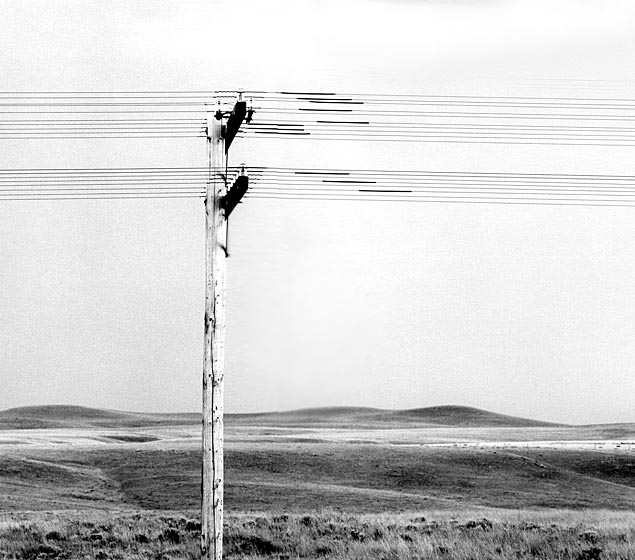
David Plowden, Fergus County, Montana, 1971
Other parts were like this:

David Plowden, LTVB Corp., Indiana Harbor Works, East Chicago, Indiana, 1980
The trip was like a going back in historical time:
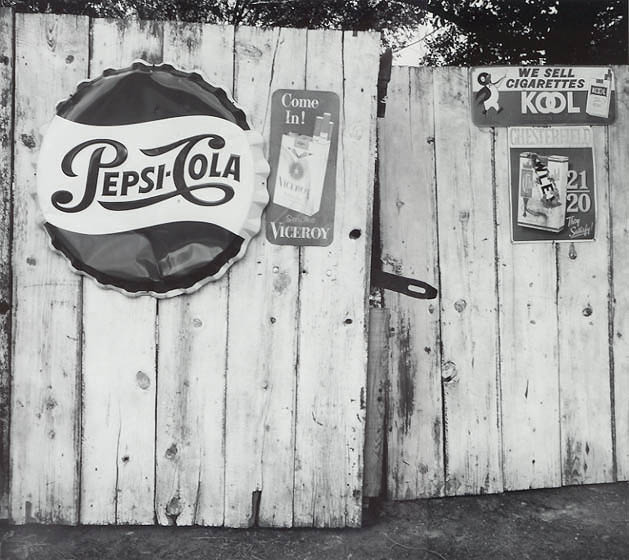
David Plowden, Signs on fence, Watrous, New Mexico, 1968
It was stepping into another time:
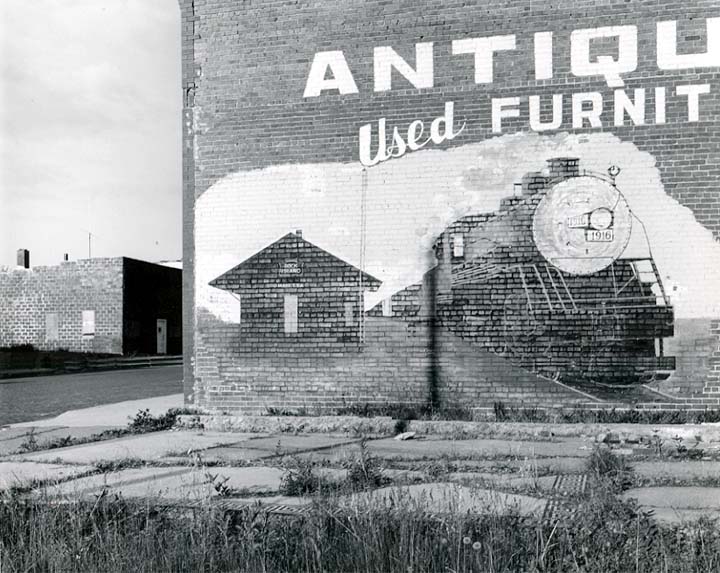
David Plowden, Mayetta, Kansas, 1991
The old folks feared the future. They were being forgotten and pushed into the shadows.
The kids stood on the threshold of the digital age. They desired something new. But they too were fearful. The schools had failed them. They had not been skilled to cope with the digitial age. They had no confidence in themselves.
They too were being forgotten and pushed into the shadows.
Neither group connected to this world or talked about these things.
But they knew that the social democratic state had given them the flick, let them in the shadowlands of poverty and forgotten about them.
After travelling the country I end with this emotion expressed thus:

David Plowden, Funeral parlor, Prairie Home, Missouri, 1974
I despaired because I knew that the new modernized social democrats would do little to enable these people to live more flourishing lives.
September 22, 2004
Antartica
The impact of global warming:
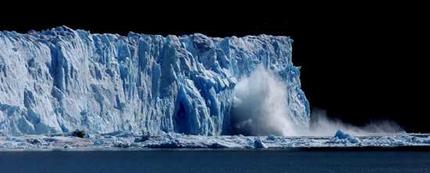
Ice crashes down from the Perito Moreno Glacier off Argentina last year.
The affected area is at the far northern tip of the Antarctic, just south of Chile and Argentina. Temperatures there have risen by up to 2.5 degrees C in the past 60 years - faster than almost any region in the world.
In the past 30 years, ice shelves in the region have lost more than 13,500 sq km of area.
September 21, 2004
Bernice Abbott
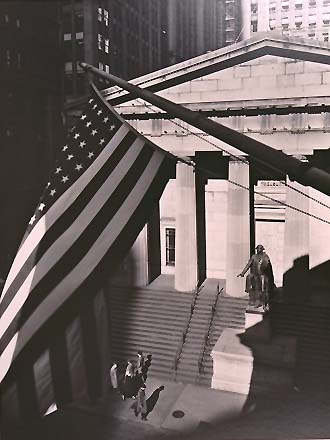
Bernice Abbott, Treasury Building, New York
She tried to preserve the nineteenth century buildings in New York before they were pulled down to make way for the new skycrapers that celebrated the modernity of industrial capitalism.
September 20, 2004
Spyware
 I've been struggling with this issue all weekend at the holiday shack in Victor Harbor.
I've been struggling with this issue all weekend at the holiday shack in Victor Harbor.
The shack has a backup computer running Windows '98 with dial-up internet. It has been running very slow. So I guessed it was jam packed with spyware. And it was.
Microsoft has been very poor in allowing this to happen, and in no longer supporting Windows '98.We ar eleft to our own devices. So off to Open Source Software we go.
The article from the New York Times says that:
"The parasitic files that have beset ....frustrated computer users are known, in tech argot, as spyware and adware. The rapid proliferation of such programs has brought Internet use to a stark crossroads, as many consumers now see the Web as a battlefield strewn with land mines....spyware generally refers to programs that reside in hidden corners of a computer's hard drive and record confidential information like keystrokes, passwords and the user's history of Web site visits. Adware, for its part, marries old-fashioned highway billboard pitches to online distribution and the possibility of immediate response."
I detest adware and loathe spyware, as the latter creeps onto my computer's hard drive unannounced, often by sneaking through backdoor security gaps in Web browsers when consumers visit certain sites.
Spyware (or tracking software) uses my Internet connection to continuously contact the "home server" and report statistical data. Therefore, my computer is, in effect, turned into a server sending information about me and my Internet habits to a remote location without my consent.
As a result, your computer will likely experience a degradation of system performance and sporadic Internet connectivity. The result is described in the article in terms of our computer screens being:
"....transformed into digital versions of Times Square, and overburdened PC's that operate much more slowly as they struggle with random and uncontrollable processes prompted by the hard drive. Small wonder that consumers are throwing up their hands in despair."
The computer has been hijacked by nasty capitalists such as Gator Corporation.
 I have pretty much followed this advice.
I have pretty much followed this advice.
And this.
It is now a matter of trying to scan and clean the spywear out the computers.
Then I need to find ways to protect my system against further infestations by spyware and adware as best as I can, given the shonky and misleading product on the internet.
September 19, 2004
Lee Miller
Lee Miller was an exponent of surrealism in photography which showed the world anew and strange.

Lee Miller,Portrait of Space, 1936 near Siwa Egypt
More photographs at the Lee Miller archive
Miller was versatile, as she was able to shift from fashion to war journalism:
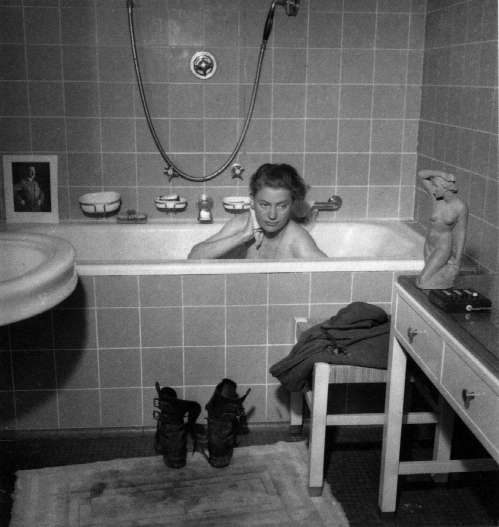
Lee Miller, Hitler's Residence, Munich, Germany, Lee Miller & Dave Scherman
The men in the surrealist movement talked their aesthetic philosophy but Miller lived it.
September 18, 2004
culture & politics
My comment on the previous week of the federal election in Australia:
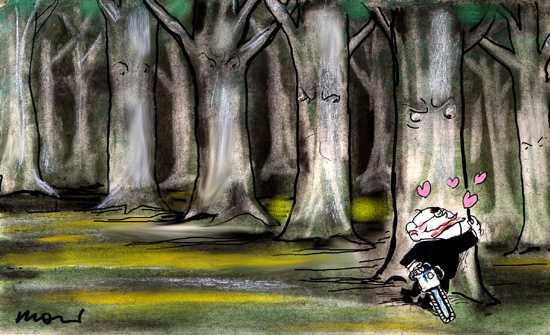
Moir
The Coalition has recently discovered the old growth forests in Tasmania. They are doing it to retain power ---going straight for Green sympathizers first preferences in order to gouge back the Australian Greens primary votes.
It would include saving the Tarkine from logging.
But it may prevent this.
September 16, 2004
Sydney Opera House
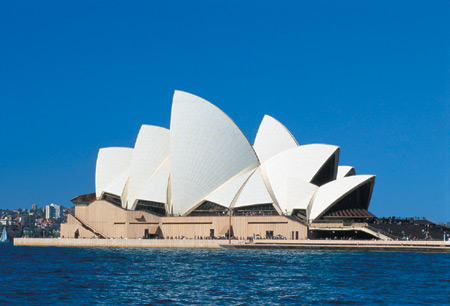
Sydney Opera House, one of the iconic 20th century buildings.
More here
An iconic site with a troubled history. Utzon had resigned in 1966, after 10 years on the job, driven out by dissension and compromise as costs skyrocketed for the difficult construction. He went back to Denmark and never returned to see the completed building until now. The depressingly pedestrian interiors that were designed by others after his departure have always been a letdown from the poetic presence in the harbor.
A wrong has been righted. Almost 40 years after he left, Jorn Utzon has been called back to redo the interiors in the spirit of his original design. He was named consulting architect three years ago, for as long as the work continues.
Thirty years of performances and tourism had taken their toll. The interiors of the Opera House are being ďrefurbished,Ē a polite word for major revisions to deal with developments in the performing arts and the way the building is used. Utzon was recalled so as to put things right that were so blatantly wrong. It is a retrofitting. now under way, is being funded by the City of Sydney and the Sydney Opera House Trust, with an allocation of 45 million Australian dollars (about $30 million) from the New South Wales Ministry for the Arts.
September 15, 2004
Sebasti„o Salgado#2
This reminds me of the south west corner of Flinders Chase National Park in Kangaroo Island in South Australia.

Sebastiao Salgado, Sea lions (Zalophus californianus) at Puerto Egas in James Bay, Santiago Island, from the Genesis Project
September 12, 2004
William Robinson#2
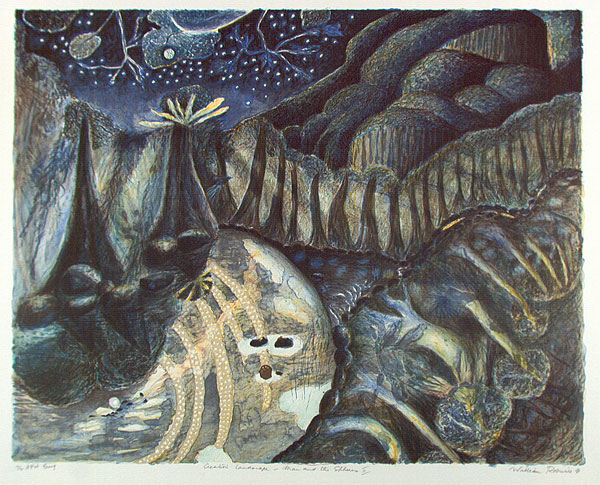
William Robinson, Creation landscape - Man and the Spheres II, 1991
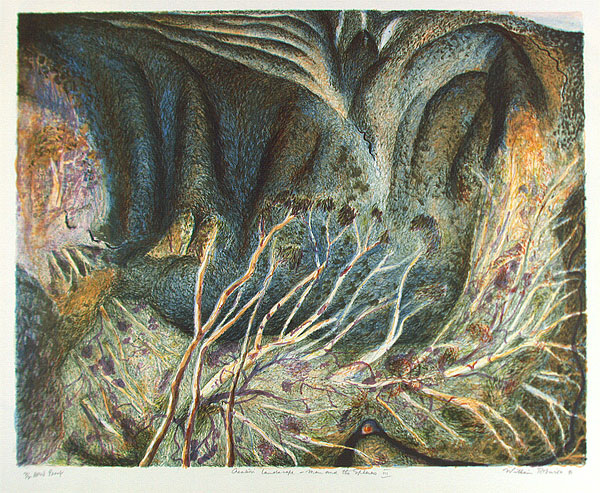
William Robinson, Creation landscape - Man and the Spheres III, 1991
Courtesy of....
I'm a bit caught up with philosophical things today so some loose links.
Courtesy of Barista
It is a very fine piece of work. I couldn't find any critical reviews of this work. Anyone know any?
This is courtesy of The Collective Lounge and Shocking

Andy Warhol, Electric Chair, 1967
This belongs to a series called "American Death", which is a period in his work when disasters in the USA - suicides, car accidents, etc. - attracted his interest.
Courtesy of Artrift then Stunned.org the weblog and then you've been haacked:

It is a parody from Mad Magazine of a TV commercial Bush would air if he were running against Jesus.
September 11, 2004
D.H. Lawrence
It was about 40 years ago that D.H.Lawrence was very popular amongst progressive lefties in the literary institution. He was celebrated for his exaltation of sexuality; for freeing up our sexual instincts from the bourgeois repressive moral codes and conservative sexual mores.
All this was very Nietzschean, in that the life force of sex should affirm rather than deny life. Lawrence was opposed to those who said no to life.
Lawrence spent some time in Australia.
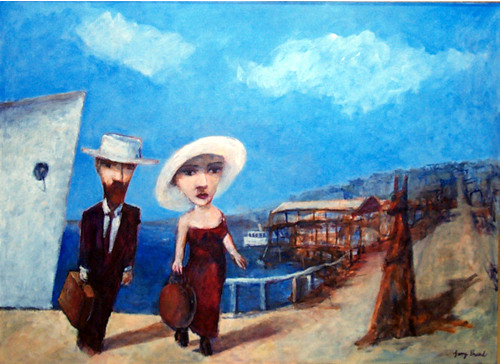
Gary Shead, The Arrival,
Whilst here in Australia Lawrence wrote Kangaroo:
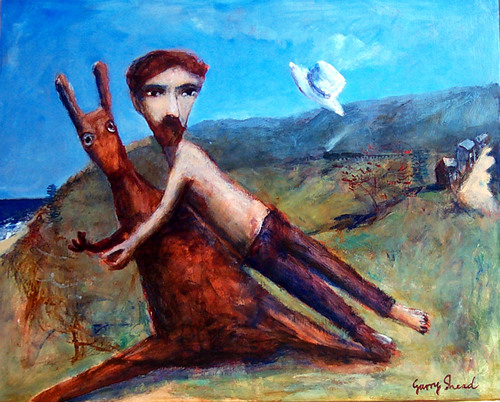
Garry Shead, Lawrence and Kangaroo, DH Lawrence Series 1993.
I wasn't that much taken with Lawrence. No modernist, but a fine writer. But Lawrence's celebration of sexuality was a celebration of male sexuality:
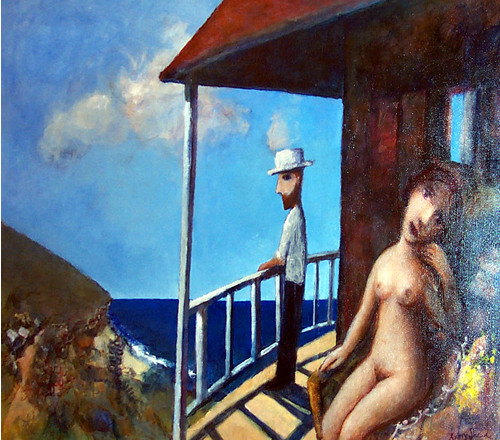
Garry Shead, The Viewer, DH Lawrence Series, 1992
Lawerence used to be a central figure in Fr. Leavis' The Great Tradition: a culmination of a literary tradition that embraced Jane Austen and Henry James and which 'felt life.'
Lawrence has fallen out of favour now.
September 10, 2004
Garry Shead#3
The young queen naked. The British monarchy stripped of its symbolism and institutional role.

Garry Sheed, Bare Queen, 1995
From the series Encounters with Royalty:

Our national identity was once tied wup with being British subjects not Australian citizens. Now we are Australian citizens.
The problem is not simply one of removing the British monarch. It has more to do with recognizing the Aboriginal people as the original owners of this country and with special rights.
Now that would be a proper departure from colonial origins. It would be a genuine refounding.
September 08, 2004
Garry Shead#2
These works by Sheed reach back to the 1950s and the royal tour.
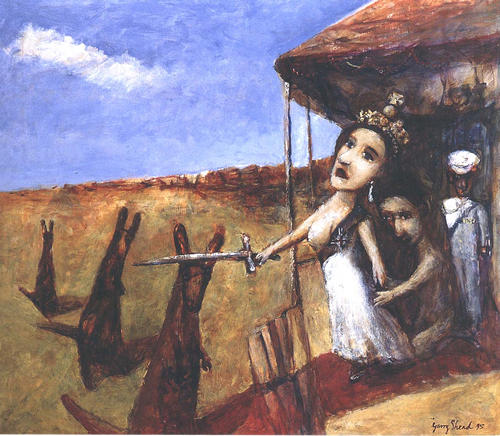
Gary Shead,Knighthoods, 1995 'Encounters with Royalty',
The Queen does appear to stand for the British conquest of aboriginal land in Australia and a legitimation of that conquest.
Is there any recognition of aboriginal claims?
September 07, 2004
Garry Shead#1
We need a republican vision for Australia that stands in opposition to the archaic constitutional monarchy we have today.
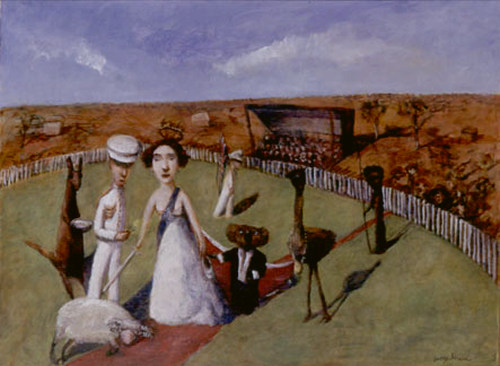
Garry Shead,Knighting the Ram, 1997-98
In the 1990s we were offered a very trimmed down version of republicanism by Malcolm Turnbull and Paul Keating. Their minimalist republic limited the vision of an Australian republic to the nationality of a head of state.
Such a republic had nothing to say about the Aboriginal people.
September 06, 2004
Philip Hunter
The image is of Western Victoria's Wimmera district.
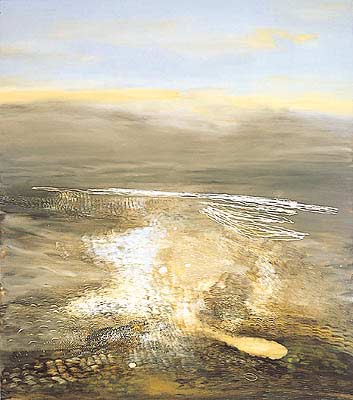
Philip Hunter, Day Plains X, 2002
Hunter is seen as reinventing the landscape tradition in Australia.

Philip Hunter, Day Plains VII, 2002
What we are offered is an ethos of place as an individual locale instead of studio works painted from memory and full of nostalgia and sentiment.
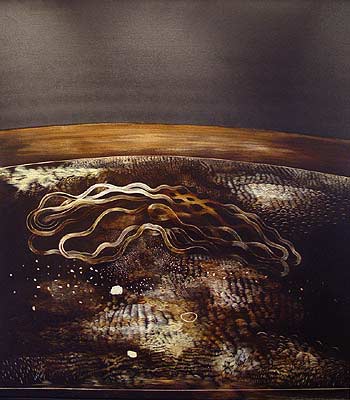
Philip Hunter, Night Plains IV, 2002
What is being referred to is a post-European settlement landscape of disappointment and failed ambitions: the failed farm, the drought, walking off the land, bushfires, salinity.
There is a reflection here about the history of white settlement. Tis time to get a little more hard headed.
Is it a reworking of the Australian sublime?
September 05, 2004
fear
One of the ways the conservatives endeavor to retain their hold on power is to create subliminal messages of fear. Bill Leak has captured their strategy well:

Leak
It is an effective piece of political criticism.
September 04, 2004
Australian Landscape: in a bind
By and large the history of Australian art has been dominated by the landscape, despite the embrace of abstraction in the 1960s and the conceptual in the 1980s.
The landscape tradition is not redundant. It cannot be avoided: it can only engaged with.
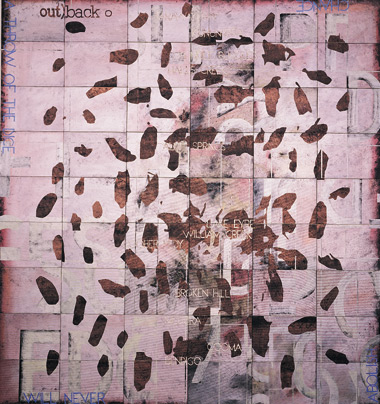
Imants Tillers, OUT)BACK 0, 2004
Tillers is a case in point. He has found most of his images in art magazines and catalogues because this is the way that most Australians view art due to their geographical remoteness. That implies European and American art. The use of the technique of appropriation is to invert the outmoded, if still prevailing order of centre to province, coloniser to colony, overlord to underdog, and to assert the artist's identity.
But what about Australian art? We are not geographically remote from that. There is something called Australian art with a unique range of concerns and loads of potential energy.
Do we not view art through the lens of our locality--our own landscape tradition? Do we not inhabit place (topographical) and experience place?

Imants Tillers, Nature Speaks Be, 2003
Is not our understanding of Australian modernity is tied to the landscape as much as it is to the machine?
However, the landscape tradition has been defined as parochial when compared to the European avant garde. The classic contrast is:
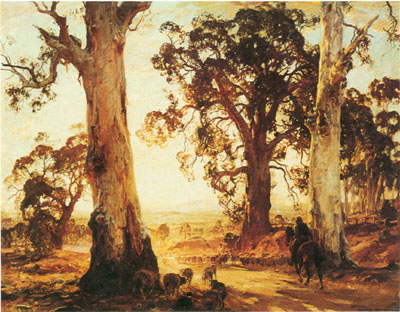
Hans Heyson, Droving into the Light
vs

Marcel Duchamp, Bride Stripped Bare by her Bachelors Even
(The Large Glass), 1915-23
Hence Australians are locked into a parochial provincial bind.
Really? What about the Aboriginal renaissance in art of the last 30 years? Does that not break up that duality?
September 03, 2004
Elle McPherson: porno chic
I saw this image in a copy of Vogue when flickering through it at the hairdressers this morning. Clearly there is a strong competition to establish bold and sexy brands in a marketplace crowded with beautiful bodies--most of them female. Hence the emergence of porno-chic in our increasingly frank sex culture.

Elle McPherson, Intimates
All those at the hairdressers agreed that the sexy image was porn, but no one was fazed by it; even though they acknowledged that the image degraded and humiliated women. Or even when they realised it was a tv commercial. It was a part of Paris fashion. Everyone was doing it.
Does this mean an acceptance of the ever-increasing mainstreaming of porn? Or that the definition of what is erotic vs. what is pornographic is now changing according to the tenor of the times and what is being created in popular culture?
It is clear that porno chic is now fashion cool; It is more than a fashion style. Its hip.
How about this suggestion. These images are not degrading to women. These are the images our culture has given us as women, and instead of rejecting them, women embrace them and play with them.í
September 02, 2004
September 01, 2004
stripped
Where have all the trees gone?

Brent Phelps, Tom Nansel, Odd Corners Ranch, Montana, 1999, Photographs from the Lewis & Clark Trail Survey
So much of South Australia is like this. It's been cleared for grazing or farming. Now we have to replant it.
It's a big job.





